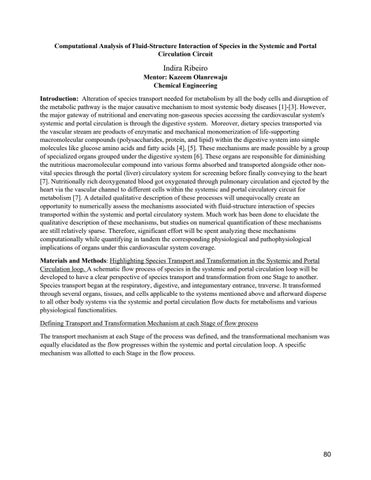Computational Analysis of Fluid-Structure Interaction of Species in the Systemic and Portal Circulation Circuit
Indira Ribeiro Mentor: Kazeem Olanrewaju Chemical Engineering Introduction: Alteration of species transport needed for metabolism by all the body cells and disruption of the metabolic pathway is the major causative mechanism to most systemic body diseases [1]-[3]. However, the major gateway of nutritional and enervating non-gaseous species accessing the cardiovascular system's systemic and portal circulation is through the digestive system. Moreover, dietary species transported via the vascular stream are products of enzymatic and mechanical monomerization of life-supporting macromolecular compounds (polysaccharides, protein, and lipid) within the digestive system into simple molecules like glucose amino acids and fatty acids [4], [5]. These mechanisms are made possible by a group of specialized organs grouped under the digestive system [6]. These organs are responsible for diminishing the nutritious macromolecular compound into various forms absorbed and transported alongside other nonvital species through the portal (liver) circulatory system for screening before finally conveying to the heart [7]. Nutritionally rich deoxygenated blood got oxygenated through pulmonary circulation and ejected by the heart via the vascular channel to different cells within the systemic and portal circulatory circuit for metabolism [7]. A detailed qualitative description of these processes will unequivocally create an opportunity to numerically assess the mechanisms associated with fluid-structure interaction of species transported within the systemic and portal circulatory system. Much work has been done to elucidate the qualitative description of these mechanisms, but studies on numerical quantification of these mechanisms are still relatively sparse. Therefore, significant effort will be spent analyzing these mechanisms computationally while quantifying in tandem the corresponding physiological and pathophysiological implications of organs under this cardiovascular system coverage. Materials and Methods: Highlighting Species Transport and Transformation in the Systemic and Portal Circulation loop. A schematic flow process of species in the systemic and portal circulation loop will be developed to have a clear perspective of species transport and transformation from one Stage to another. Species transport began at the respiratory, digestive, and integumentary entrance, traverse. It transformed through several organs, tissues, and cells applicable to the systems mentioned above and afterward disperse to all other body systems via the systemic and portal circulation flow ducts for metabolisms and various physiological functionalities. Defining Transport and Transformation Mechanism at each Stage of flow process The transport mechanism at each Stage of the process was defined, and the transformational mechanism was equally elucidated as the flow progresses within the systemic and portal circulation loop. A specific mechanism was allotted to each Stage in the flow process.
80






















